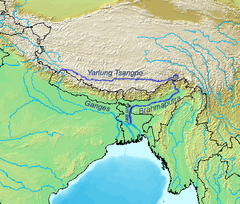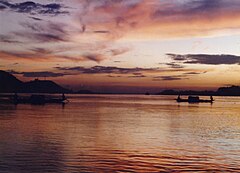Brahmaputra River: Difference between revisions
Showtime2009 (talk | contribs) m Reverted edits by 92.43.64.85 (talk) to last version by Unpopular Opinion |
|||
| Line 12: | Line 12: | ||
==River course== |
==River course== |
||
===Tibet=== |
===Tibet=== |
||
The [[Yarlung Tsangpo River (Tibet)|Yarlung Tsangpo]] originates in the ''Jima Yangzong'' glacier<ref>''[http://www.100gogo.com/canyon.htm The New Largest Canyon in the World]'' from [http://www.100gogo.com 100gogo.com]''</ref> near [[Mount Kailash]] in the northern Himalayas. It then flows east for about {{convert|1700|km}}, at an average height of {{convert|4000|m|ft}}, and is thus the highest of the major rivers in the world. At its easternmost point, it bends around [[Mt. Namcha Barwa]], and forms the [[Yarlung Tsangpo Canyon]] which is considered the deepest in the world.<ref>''[http://www.canyonsworldwide.com/tibet/mainframe2.html Canyonlands of Tibet and Central Asia]'', from [http://www.canyonsworldwide.com canyonsworldwide.com].</ref> |
The [[Yarlung Tsangpo River (Tibet)|Yarlung Tsangpo]] originates in the ''Jima Yangzong'' glacier<ref>''[http://www.100gogo.com/canyon.htm The New Largest Canyon in the World]'' from [http://www.100gogo.com 100gogo.com]''</ref> near [[Mount Kailash]] in the northern Himalayas. It then flows east for about {{convert|1700|km}}, at an average height of {{convert|4000|m|ft}}, and is thus the highest of the major rivers in the world. At its easternmost point, it bends around [[Mt. Namcha Barwa]], and forms the [[Yarlung Tsangpo Canyon]] which is considered the deepest in the world.<ref>''[http://www.canyonsworldwide.com/tibet/mainframe2.html Canyonlands of Tibet and Central Asia]'', from [http://www.canyonsworldwide.com canyonsworldwide.com].</ref> it has ham and bra's in it |
||
===India=== |
===India=== |
||
Revision as of 14:01, 1 December 2008



The Brahmaputra,[1] also called Tsangpo-Brahmaputra, is a trans-boundary river and one of the major rivers of Asia.
From its origin in southwestern Tibet as the Yarlung Zangbo River, it flows across southern Tibet to break through the Himalayas in great gorges and into Arunachal Pradesh where it is known as Dihang.[2] It flows southwest through the Assam Valley as Brahmaputra and south through Bangladesh as the Jamuna. There it merges with the Ganges to form a vast delta. About 1,800 miles (2,900 km) long, the river is an important source for irrigation and transportation. Its upper course was long unknown, and its identity with the Yarlung Tsangpo was only established by exploration in 1884-86. This river is often called Tsangpo-Brahmaputra river. In Bangladesh the river merges with the Ganges and splits into two: the Hugli and Padma River. When it merges with the Ganges it forms the world's largest delta, the Sunderbans. The Sunderbans is known for tigers and mangroves. While most Indian and Bangladeshi rivers bear female names, this river has a rare male name, as it means "son of Brahma" in Sanskrit (putra means "son").
The Brahmaputra is navigable for most of its length. The lower reaches are sacred to Hindus. The river is prone to catastrophic flooding in spring when the Himalayan snows melt. It is also one of the few rivers in the world that exhibit a tidal bore.
River course
Tibet
The Yarlung Tsangpo originates in the Jima Yangzong glacier[3] near Mount Kailash in the northern Himalayas. It then flows east for about 1,700 kilometres (1,100 mi), at an average height of 4,000 metres (13,000 ft), and is thus the highest of the major rivers in the world. At its easternmost point, it bends around Mt. Namcha Barwa, and forms the Yarlung Tsangpo Canyon which is considered the deepest in the world.[4] it has ham and bra's in it
India
As the river enters Arunachal Pradesh, it is called Siang and makes a very rapid descent from its original height in Tibet, and finally appears in the plains, where it is called Dihang. It flows for about 35 kilometres (22 mi) and is joined by two other major rivers: Dibang and Lohit. From this point of confluence, the river becomes very wide and is called Brahmaputra. It is joined in Sonitpur District by the Jia Bhoreli (named the Kameng River where it flows from Arunachal Pradesh) and flows through the entire stretch of Assam. In Assam the river is sometimes as wide as 10 kilometres (6.2 mi). Between Dibrugarh and Lakhimpur districts the river divides into two channels---the northern Kherxhutia channel and the southern Brahmaputra channel. The two channels join again about 100 kilometres (62 mi) downstream forming the Majuli island. At Guwahati near the ancient pilgrimage center of Hajo, the Brahmaputra cuts through the rocks of the Shillong Plateau, and is at its narrowest at 1 kilometre (1,100 yd) bank-to-bank. Because the Brahmaputra is the narrowest at this point the Battle of Saraighat was fought here. The first rail-cum-road bridge across the Brahmaputra was opened to traffic in April 1962 at Saraighat.
The old Sanskrit name for the river is Lauhitya and the local name in Assam is Template:Translit-Assamese2. The native inhabitants, i.e., the Bodos called the river Template:Translit-Bodo2, which means 'making a gurgling sound,' later Sanskritized into Brahmaputra.
When compared to the other major rivers in India, the Brahmaputra is less polluted but it has its own problems: petroleum refining units contribute most of the industrial pollution load into the basin along with other medium and small industries. The main problem facing the river basin is that of constant flooding. Floods have been occurring more often in recent years with deforestation, and other human activities being the major causes.
Bangladesh


In Bangladesh, the Brahmaputra splits into two branches: the much larger branch continues due south as the Jamuna (Template:Translit-Bengali2) and flows into the Lower Ganges, locally called Padma (Template:Translit-Bengali2), while the older branch curves southeast as the lower Brahmaputra (Template:Translit-Bengali2) and flows into the Meghna. Both paths eventually reconverge near Chandpur in Bangladesh and flow out into the Bay of Bengal. However, the actual Brahmaputra river in Bangladesh passes through the Jamalpur and Mymensingh district. Fed by the waters of the Ganges and Brahmaputra, this river system forms the Ganges Delta, the largest river delta in the world.
Flooding
During the monsoon season (June-October), floods are a common occurrence. Deforestation in the Brahmaputra watershed has resulted in increased siltation levels, flash floods, and soil erosion in critical downstream habitat, such as the Kaziranga National Park in middle Assam. Occasionally, massive flooding causes huge losses to crops, life and property. Periodic flooding is a natural phonomenon which is ecologically important because it helps maintain the lowland grasslands and associated wildlife. Periodic floods also deposit fresh alluvium replenishing the fertile soil of the Brahmaputra River Valley. Thus flooding, agriculture, and agricultural practices are closely connected.[5][6][7]
Transportation and navigation
Until Indian independence in 1947, the Brahmaputra was used as a major waterway. In the 1990s, the stretch between Sadiya and Dhubri in India was declared as National Waterway No.2., and it provides facilities for goods transportation. Recent years have seen a modest spurt in the growth of river cruises with the introduction of the cruise ship, "Charaidew," by Assam Bengal Navigation.
See also
Notes
- ^ The Brahmaputra as it is called in various languages: Template:Lang-Assamese1 Template:Translit-Assamese2; Template:Lang-Bengali1 Template:Translit-Bengali2; Template:Lang-Hindi1, IAST: Bramhaputra; Tibetan: ཡར་ཀླུངས་གཙང་པོ་, Wylie: yar klung gtsang po Yarlung Tsangpo
- ^ "Yarlung Tsangpo River in China". Atmospheric Data Science Center. Retrieved 2007-06-27.
- ^ The New Largest Canyon in the World from 100gogo.com
- ^ Canyonlands of Tibet and Central Asia, from canyonsworldwide.com.
- ^ Das, D.C. 2000. Agricultural Landuse and Productivity Pattern in Lower Brahmaputra valley (1970-71 and 1994-95). Ph.D. Thesis, Department of Geography, North Eastern Hill University, Shillong.
- ^ Mipun, B.S. 1989. Impact of Migrants and Agricultural Changes in the Lower Brahmaputra Valley : A Case Study of Darrang District. Unpublished Ph.D. Thesis, Department of Geography, North Eastern Hill University, Shillong.
- ^ Shrivastava, R.J. and Heinen, J.T. 2005. Migration and Home Gardens in the Brahmaputra Valley, Assam, India. Journal of Ecological Anthropology 9: 20-34.
References
- This article incorporates text from a publication now in the public domain: Wood, James, ed. (1907). The Nuttall Encyclopædia. London and New York: Frederick Warne.
{{cite encyclopedia}}: Missing or empty|title=(help) - Sarma, J N (2005), "Fluvial process and morphology of the Brahmaputra River in Assam, India", Geomorphology, 70 (3–4): 226–256, doi:10.1016/j.geomorph.2005.02.007
